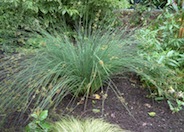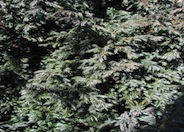
Common name:California Gray Rush
Botanical name:Juncus patens
Although a wetland plant, Juncus patens can tolerate fairly dry conditions. It will slowly clump to 2'-3' wide and a height of 2'-2.5'. There are many selections of this species available with different heights and widths. It is carefree, with little to no maintenance. It provides great upright structure to many styles of landscapes.

Common name:Catmint
Botanical name:Nepeta X faassenii
Nepeta faassenii makes soft, gray green, undulating mounds that are 1.5' high when blooming. The small leaves are attractive to cats. This perennial has lavender blue flowers in late spring and early summer.

Common name:Eastern Redbud
Botanical name:Cercis canadensis
This small, deciduous tree with a rounded head is covered with small flowers of a rose pink color in the spring before the appearance of heart-shaped leaves. It can grow to 25' tall with an equal spread. It has a low branching habit with a rounded form. Leaves turn yellow green in the fall.

Common name:
Botanical name:

Common name:Sea Pink, Common Thrift
Botanical name:Armeria maritima
This clumping, grass-like perennial is native to many areas, including coastal CA. Its flowers range from deep rose pink through white. -Monterey Bay Nursery

Common name:Giant Feather Grass
Botanical name:Stipa gigantea
This grass will grow 2'-3' tall and 2'-3' wide. It has narrow, dark green leaves with golden flowers that bloom in the summer. Tall grasses are highly combustible.
Pest Management
Are pests bugging you? If pests are taking over there might be a good reason! Instead of grabbing that bottle of spray, consider using techniques that can solve your pest problems without toxic pesticides.
Click in the green box for more information
| Designer: Rick Fisher | Corner Garden |
Photographer: GardenSoft |
Soils and Compost:
Practice grass-cycling by leaving short grass clippings on lawns after mowing, so that nutrients and organic matter are returned to the soil.
Water Saving Tip:
Mulching and adding compost to soil can minimize evaporation and help soil absorb and store water.
Integrated Pest Management:
Remove irrigation water and fertilizer from areas where you don't want weeds to grow.
